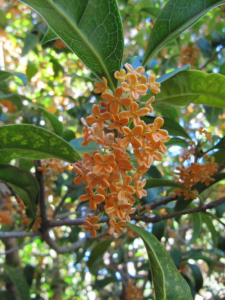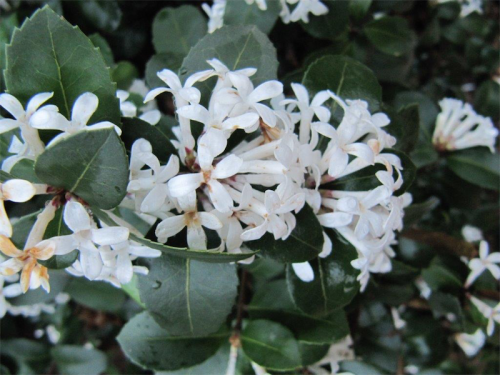I haven’t found a common name for it, but this small tree is coming into flower right now providing autumn colour to the garden.
Usually hard to find (I don’t know why), I did see some recently at Heritage Nursery, Yarralumla.
Another Osmanthus of special interest is Osmanthus “Heaven Sent”. Flowering from late winter into spring, this compact shrub grows to two metres, although can be clipped to keep it smaller.
An evergreen, it can either be used for a hedge or as a stand-alone shrub. Its white tubular flowers, set against the dark green leaves, have an amazing perfume.
The third variety Osmanthus fragrans can be grown as a tall shrub or small tree.
First introduced to the west in 1771, it is one of the most popular garden plants grown in China for the delicious perfume of its clusters of tiny white flowers. The Chinese use the flowers as pot pourri and for flavouring tea and wine. Grown in China for more than a thousand years, it is known as the “gui” flower, meaning noble.
Osmanthus fragrans is also a symbol of literary merit and an emblem of studious pursuits.
TO complement the special fragrance of the various Osmanthus shrubs one should consider Sarcococca ruscifolia or “Sweet Box”(no relation to Buxus, as used in box hedging).With its dark green leaves and fragrant white flowers, it is an ideal companion to grow at the base of or in front of Osmanthus. “Sweet Box” is relatively slow growing to about half to one metre tall with a one metre spread.
THE regular advice for new gardens is to dig in gypsum to break up the clay. The problem with gypsum is that it is normally only possible to dig to about a spade’s depth and it won’t penetrate the soil either deeper or sideways.
A better solution is Multicrop’s “Clay Breaker”, a solution that’s mixed with water. It soaks deep into the soil and, if applying to a planting hole, will spread sideways through the clay soil.
Apply a bucketful to a planting hole and wait until it has drained completely which may take a few hours or a day to drain depending on the density of the clay.
An additional advantage is if existing shrubs are not doing well in clay soil, gypsum can’t be applied later. Whereas Clay Breaker can be applied by making a small bank around the drip line of the shrub.
It is available from most garden centres or DIY centres.
THE Eurobodalla Regional Botanic Gardens at Batemans Bay is holding an Easter fair and giant plant sale, 10am-4pm, on Easter Saturday. More information at erbg.org.au
Jottings…
- In my continuous recommendations of organic fertilisers, there’s Healthy Earth with an NPK of 7:3:8.5. The low phosphorus is ideal for natives and especially for flowering and fruiting plants with its high potassium.
- Plant seedlings of Asian greens, onions and chives.
- Plant bulbs and more bulbs… throw them up in the air and plant where they land!
- Plant garlic, but only Australian garlic. Chinese garlic is treated with chemicals and will not grow. The best selection of Australian-grown garlic is available at the Farmers Market at Epic.
The post Gardening / Gosh, wow, what a fragrance! appeared first on Canberra CityNews.

